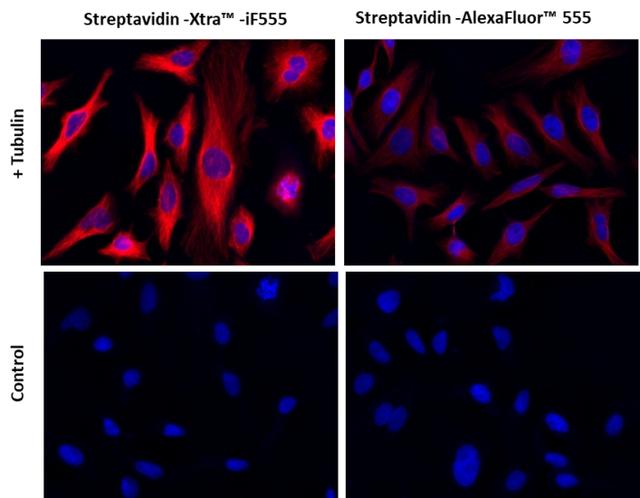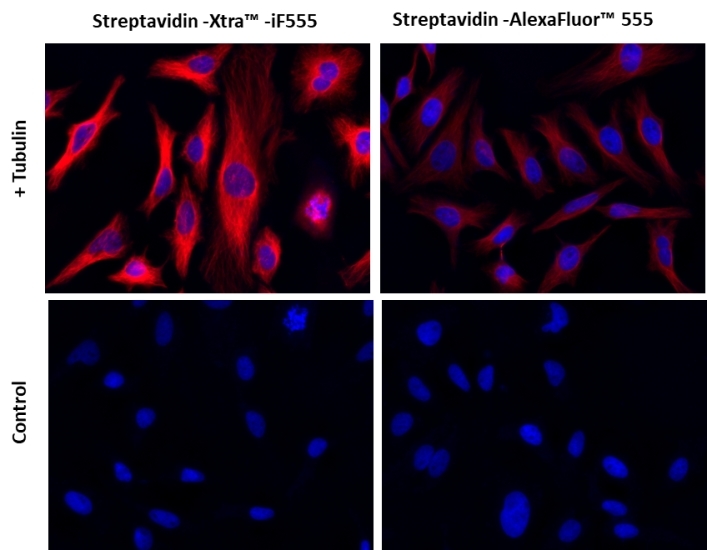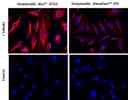Streptavidin-Xtra™ IF555
Example protocol
PREPARATION OF STOCK SOLUTIONS
Unless otherwise noted, all unused stock solutions should be divided into single-use aliquots and stored at -20 °C after preparation. Avoid repeated freeze-thaw cycles
Add 100 µL (For Cat# 46002) or 1 mL (For Cat# 46003) of ddH2O to the vial to make a 1 mg/mL stock solution.
Note: This constituted stock solution will be in PBS with 0.2% BSA.
PREPARATION OF WORKING SOLUTION
For IF, the recommended staining concentration is 1-5 μg/mL. For FACS, the suggested concentration is 0.1-0.5 μg/100 μL/million cells in the staining buffer.
Note: PBS + 0.1% BSA can be used as a staining buffer.
Note: For the best performance of each application, the optimal concentration of this reagent needs to be carefully determined.
Note: The suggested working dilution is provided as a guide only. It is recommended that the users titrate the product in their tests using proper positive and negative controls.
SAMPLE EXPERIMENTAL PROTOCOL
- Block and treat the samples with antibodies of interest as per the manufacturer's recommendations.
Add biotin-conjugated secondary antibody working solution in the samples at appropriate concentration and duration.
Note: Please verify the compatibility and type of your biotin-conjugated antibody with the primary antibody used in the experiment. For example, If the primary antibody is a mouse antibody, then a goat Anti-Mouse antibody bound with biotin can be used for the assay.
- Incubate the cells with Streptavidin-Xtra™ working solution at room temperature for 30 minutes to 1 hour. Note: Optimal time for incubation needs to be determined carefully.
- Remove the working solution and resuspend the cells in your choice of buffer.
- Take the image using the fluorescence microscope or record the intensity using flow cytometer.
Spectrum
Product family
| Name | Excitation (nm) | Emission (nm) | Extinction coefficient (cm -1 M -1) | Quantum yield | Correction Factor (260 nm) | Correction Factor (280 nm) |
| Streptavidin-Xtra™ IF488 | 491 | 516 | 750001 | 0.91 | 0.21 | 0.11 |
| Streptavidin-Xtra™ IF594 | 568 | 587 | 1000001 | 0.571 | 0.34 | 0.15 |
| Streptavidin-Xtra™ IF647 | 656 | 670 | 2500001 | 0.251 | 0.03 | 0.03 |
Citations
Authors: Duda, Heidi C and Sprenzel, Carolin J and Didier, Andrea and Scholz, Armin M and Deeg, Cornelia A and Degroote, Roxane L
Journal: Scientific Reports (2025): 9401
Authors: Wei, Y. P., Liu, X. P., Mao, C. J., Niu, H. L., Song, J. M., Jin, B. K.
Journal: Biosens Bioelectron (2018): 99-103
Authors: Yang, Z., Lan, Q., Li, J., Wu, J., Tang, Y., Hu, X.
Journal: Biosens Bioelectron (2017): 312-318
Authors: Hao, K., He, Y., Lu, H., Pu, S., Zhang, Y., Dong, H., Zhang, X.
Journal: Anal Chim Acta (2017): 114-120
Authors: Mishina, M., Minamihata, K., Moriyama, K., Nagamune, T.
Journal: Biomacromolecules (2017): 311



